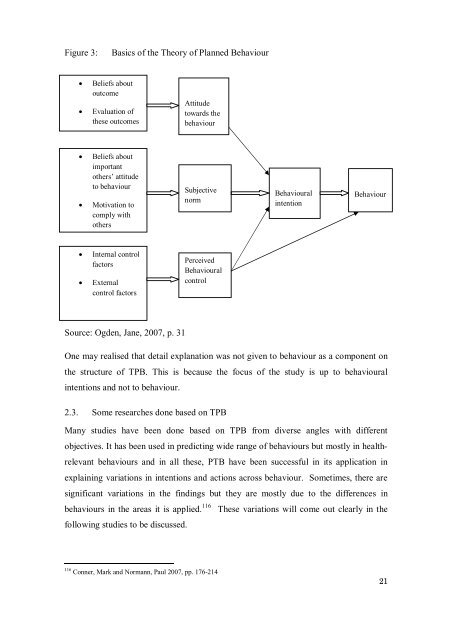A QUANTITATIVE APPROACH TO PREDICT ... - SuSanA
A QUANTITATIVE APPROACH TO PREDICT ... - SuSanA
A QUANTITATIVE APPROACH TO PREDICT ... - SuSanA
You also want an ePaper? Increase the reach of your titles
YUMPU automatically turns print PDFs into web optimized ePapers that Google loves.
Figure 3:<br />
Basics of the Theory of Planned Behaviour<br />
<br />
<br />
Beliefs about<br />
outcome<br />
Evaluation of<br />
these outcomes<br />
Attitude<br />
towards the<br />
behaviour<br />
<br />
<br />
Beliefs about<br />
important<br />
others’ attitude<br />
to behaviour<br />
Motivation to<br />
comply with<br />
others<br />
Subjective<br />
norm<br />
Behavioural<br />
intention<br />
Behaviour<br />
<br />
<br />
Internal control<br />
factors<br />
External<br />
control factors<br />
Perceived<br />
Behavioural<br />
control<br />
Source: Ogden, Jane, 2007, p. 31<br />
One may realised that detail explanation was not given to behaviour as a component on<br />
the structure of TPB. This is because the focus of the study is up to behavioural<br />
intentions and not to behaviour.<br />
2.3. Some researches done based on TPB<br />
Many studies have been done based on TPB from diverse angles with different<br />
objectives. It has been used in predicting wide range of behaviours but mostly in healthrelevant<br />
behaviours and in all these, PTB have been successful in its application in<br />
explaining variations in intentions and actions across behaviour. Sometimes, there are<br />
significant variations in the findings but they are mostly due to the differences in<br />
behaviours in the areas it is applied. 116 These variations will come out clearly in the<br />
following studies to be discussed.<br />
116 Conner, Mark and Normann, Paul 2007, pp. 176-214<br />
21
















